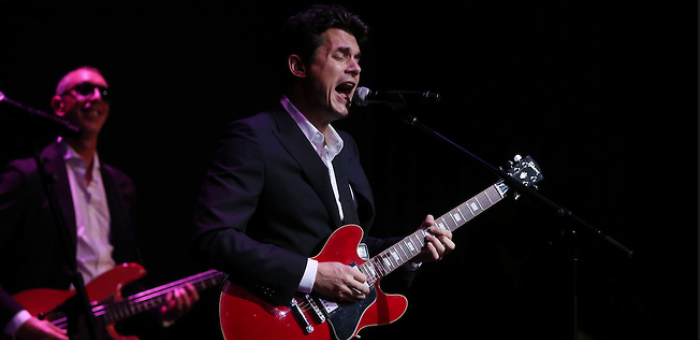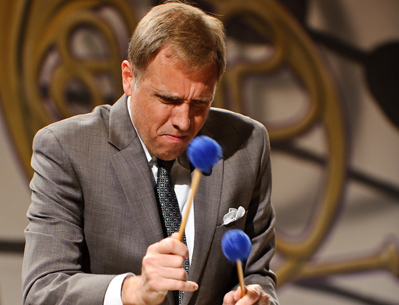Dec 9, 2025 12:28 PM
In Memoriam: Gordon Goodwin, 1954–2025
Gordon Goodwin, an award-winning saxophonist, pianist, bandleader, composer and arranger, died Dec. 8 in Los Angeles.…

John Mayer (foreground) and Pino Palladino perform at the 15th annual Jazz Foundation of America Gala in New York on Oct. 27.
(Photo: (Photo: © Udo Salters Photography))The Jazz Foundation of America’s annual “Great Night In Harlem” gala, held this year at the Apollo Theater on Oct. 27, was a grand affair, a celebration befitting the organization’s mission—to prevent illness, hunger and homelessness for jazz and blues musicians who have fallen on hard times.
With that mission in mind, the Apollo Theater—Harlem’s beacon of culture and art—opened its doors to some of jazz’s most ardent supporters, ushering in a crowd whose largesse sustains an art form with roots not far from the theater stage.
By the end of the night, there would be plenty of music made, numerous cocktails served and scores of cornbread muffins consumed. Emcee Joe Morton, known for his role on the TV show Scandal, was cordial and humorous, but even through such veils of merriment, painful memories had a way of seeping in. The concert was held in part to raise money for victims of the recent floods in Baton Rouge, where entire houses, churches and band rooms had been filled with water.
In an address to the crowd during the gala, Wendy Oxenhorn, JFA’s executive director, underscored the seriousness of the disaster, calling it “Katrina all over again,” and announced a $1 million fundraising goal to aid musicians and residents in need. The organization had already raised $500,000 toward that end, but more funds were needed, and to represent the urgency of the situation, Oxenhorn brought to the stage a family of three to share their story of loss.
With hardship still fresh in his voice, the father of the family recalled in painful detail the night he went to sleep in dry clothes and woke up with floodwater lapping at his chest.
“My refrigerator was floating through the kitchen,” he said.
Through a mid-concert auction, organizers would end up raising $438,000 in charitable donations that night, a considerable display of generosity. But as anyone associated with the JFA will tell you, it’s the musicians who provide the truly important gifts.
And so the gala began, fittingly, with a showing of gratitude. The Titans of Jazz Award was presented by special guest Danny Glover to a trio of individuals well deserving of that title: pianist Harold Mabern, bassist Bob Cranshaw and Dr. Frank Forte, a hematologist whose selfless work with the Dizzy Gillespie Memorial Fund provided millions of dollars in health care to musicians lacking access to medical services.
More awards would be handed out that night, but not before the audience was treated to some music. The night’s program—curated by drummer Steve Jordan—began with a musician whose jazz lineage could be traced back more than six decades.
Riley “Zeke” Mullins was the pianist with the historic Lionel Hampton Orchestra for more than 20 years, and his turn in the spotlight on Oct. 27—performing “Summertime” alongside a sweet, evocative clarinetist—tugged the past snug up against the present.
The music of Dr. Michael White and The Original Liberty Jazz Band followed in the tailwind of that first set, adding flashes of levity and laughter to the program, courtesy of guest vocalist Thais Clark, who sang-spoke through a slick rendition of “Horn Man Blues” that dripped with innuendo and double entendre.
A star turn by actor Bruce Willis, one of Hollywood’s biggest blues boosters, crackled with energy and heat, and featured the Die Hard star alongside certified blues legend Henry Gray on piano and Robert Randolph on pedal steel guitar.
Having arrived fresh from the set of a new movie, the actor (who, perhaps a bit jet-lagged, kept wishing the audience a “Good Morning”) added howling harmonica to Gray’s vocals on “Blues Won’t Let Me Take My Rest” and barked the pugnacious lyrics to the rockabilly standard “Matchbox” as Randolph, seated behind his pedal steel guitar, flung hot, rubbery lines to the mix.
The stage then cleared to give way to the night’s second musical award ceremony, the presentation of the inaugural Hank Jones Award to pianist Dr. John, in honor of his work to advance the music of New Orleans.
Wearing a shiny purple suit and hat, the pianist—with a band that included Jon Batiste on Hammond B-3, Sarah Morrow on trombone and “Blue” Lou Marini on saxophone—charged through funky Crescent City classics like “Such A Night” and “Right Place, Wrong Time.”
The 75-year-old accepted his award with characteristic dignity and warmth. “I am honored to receive the first Hank Jones Award,” he said. “Hank was my partner and a musical inspiration to me. He will always have a special place in my heart.”
Jazz-loving pianist Brandon Goldberg, who is merely 11 years old, traveled all the way from South Florida to present the next award, which recognized jazz titan McCoy Tyner for his lifetime achievement. In a suit and tie, his hair carefully parted, Goldberg expressed his deep admiration for Tyner. “I’m blessed to be honoring him tonight,” he said.
The diminutive Goldberg then took his place behind the piano—but not before adjusting the height of the bench—to perform a composition with the sensitivity and poignancy of a musician three times his age.
The inspired gave way to the inspiration as Tyner himself took the stage, appearing alongside saxophonist Gary Bartz, bassist Avery Sharpe and drummer Ronnie Burrage. The quartet played through the pianist’s fervent “Walk Spirit, Talk Spirit” from the 1973 album Enlightenment, and though the 77-year-old may have lost some of his speed and precision, his stylistic signatures—the dominant left hand, the modal grammar, the pentatonic lines—were fresh and vivid as ever.
The Davell Crawford Choir was next to perform, singing with soul-stirring passion as they set the stage for the night’s closing act, the John Mayer Trio.
A pop scion with firm ties to the blues, Mayer led his trio through blues favorites (a version of “Every Day I Have The Blues” dedicated to B.B. King) and jewels from the Mayer Trio catalog (“Vultures,” “Gravity”).
Accompanied by trio mates Jordan and Pino Palladino, both of whom appeared on the 2005 live album Try!, Mayer later invited special guest Robert Cray to the stage to blast through Cray’s “Chicken In The Kitchen.”
A full-cast jam on “Let The Good Times Roll” brought the concert to a close. As the buoyant lyrics resonated throughout the century-old theater, the crowd seemed eager to heed the song’s advice, heading toward the exits—and off to the after-party—to keep the celebration going.
(Note: For more information on the Jazz Foundation of America, or to make a charitable donation in support of Baton Rouge flood relief, click here.)
—Brian Zimmerman

Goodwin was one of the most acclaimed, successful and influential jazz musicians of his generation.
Dec 9, 2025 12:28 PM
Gordon Goodwin, an award-winning saxophonist, pianist, bandleader, composer and arranger, died Dec. 8 in Los Angeles.…

Belá Fleck during an interview with Fredrika Whitfield on CNN.
Jan 13, 2026 2:09 PM
The fallout from the renaming of the John F. Kennedy Center for the Performing Arts to include President Donald…

Flea has returned to his first instrument — the trumpet — and assembled a dream band of jazz musicians to record a new album.
Dec 2, 2025 2:01 AM
After a nearly five-decade career as one of his generation’s defining rock bassists, Flea has returned to his first…

Dec 11, 2025 11:00 AM
DownBeat presents a complete list of the 4-, 4½- and 5-star albums from 2025 in one convenient package. It’s a great…

Vibraphonist Chuck Redd found himself in the midst of a political firestorm after canceling his gig Dec. 24 at the newly renamed Trump Kennedy Center.
Jan 6, 2026 2:32 AM
The Board of Trustees at Washington, D.C.’s Kennedy Center for the Performing Arts voted on Dec. 18 to rename the…